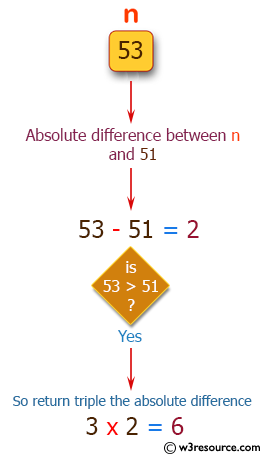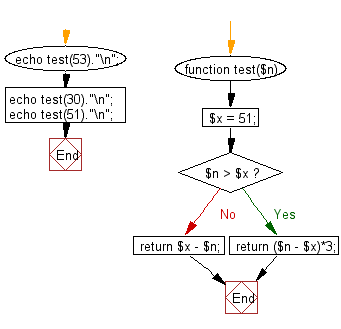PHP Exercises: Get the absolute difference between n and 51
PHP Basic Algorithm: Exercise-2 with Solution
Write a PHP program to get the absolute difference between n and 51. If n is greater than 51 return triple the absolute difference.
Sample Solution:
PHP Code :
<?php
function test($n)
{
$x = 51;
if ($n > $x)
{
return ($n - $x)*3;
}
return $x - $n;
}
echo test(53)."\n";
echo test(30)."\n";
echo test(51)."\n";
Sample Output:
6 21 0
Pictorial Presentation:

Flowchart:

PHP Code Editor:
Contribute your code and comments through Disqus.
Previous: Write a PHP program to compute the sum of the two given integer values. If the two values are the same, then returns triple their sum.
Next: Write a PHP program to check two given integers, and return true if one of them is 30 or if their sum is 30.
What is the difficulty level of this exercise?
Test your Programming skills with w3resource's quiz.
PHP: Tips of the Day
How to Sort Multi-dimensional Array by Value?
Try a usort, If you are still on PHP 5.2 or earlier, you'll have to define a sorting function first:
Example:
function sortByOrder($a, $b) {
return $a['order'] - $b['order'];
}
usort($myArray, 'sortByOrder');
Starting in PHP 5.3, you can use an anonymous function:
usort($myArray, function($a, $b) {
return $a['order'] - $b['order'];
});
And finally with PHP 7 you can use the spaceship operator:
usort($myArray, function($a, $b) {
return $a['order'] <=> $b['order'];
});
To extend this to multi-dimensional sorting, reference the second/third sorting elements if the first is zero - best explained below. You can also use this for sorting on sub-elements.
usort($myArray, function($a, $b) {
$retval = $a['order'] <=> $b['order'];
if ($retval == 0) {
$retval = $a['suborder'] <=> $b['suborder'];
if ($retval == 0) {
$retval = $a['details']['subsuborder'] <=> $b['details']['subsuborder'];
}
}
return $retval;
});
If you need to retain key associations, use uasort() - see comparison of array sorting functions in the manual
Ref : https://bit.ly/3i77vCC
- New Content published on w3resource:
- HTML-CSS Practical: Exercises, Practice, Solution
- Java Regular Expression: Exercises, Practice, Solution
- Scala Programming Exercises, Practice, Solution
- Python Itertools exercises
- Python Numpy exercises
- Python GeoPy Package exercises
- Python Pandas exercises
- Python nltk exercises
- Python BeautifulSoup exercises
- Form Template
- Composer - PHP Package Manager
- PHPUnit - PHP Testing
- Laravel - PHP Framework
- Angular - JavaScript Framework
- Vue - JavaScript Framework
- Jest - JavaScript Testing Framework
